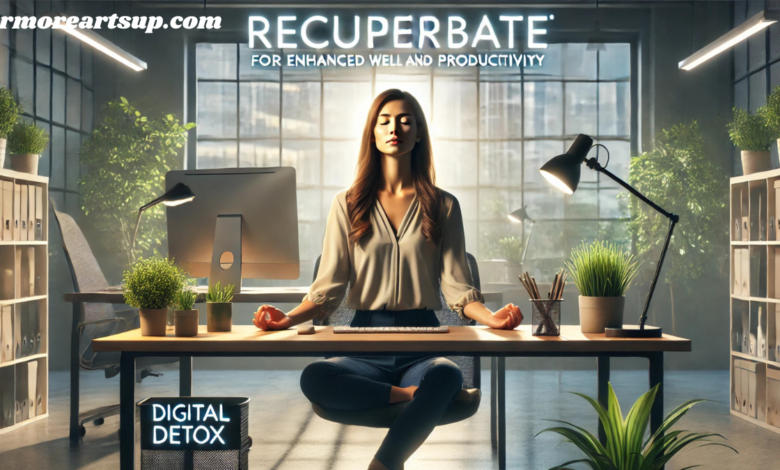Recharge to Achieve Mastering the Art of Recuperbate for Enhanced

Introduction
In our fast-paced, high-stress world, the art of Recuperbate—recuperating—is more crucial than ever. But what exactly does “Recuperbate” mean? Derived from the need to recover and rejuvenate, Recuperbate encompasses the techniques and practices that allow individuals to restore their mental and physical energy. This rejuvenation is essential for personal health and maintaining high productivity levels in professional life. This article Recuperbate the science behind adequate rest, explores various Recuperbate techniques, and provides actionable advice on incorporating these practices into your daily routine.
The Science Behind Recuperbate
Recuperbate is rooted in the biological and psychological processes regenerating our bodies and minds. When we rest, our body repairs muscle tissue while our brain reorganizes and consolidates memories, making rest periods critical for learning and memory. Psychologically, adequate rest reduces stress and anxiety, improving mood and cognitive function.
Numerous scientific studies support the benefits of proper rest. For instance, sleep, a significant Recuperbate component, enhances immune function and reduces the risk of many chronic diseases. Moreover, mental breaks and downtime can dramatically improve creative problem-solving and long-term decision-making skills.
Psychological Recuperbate Methods
Engaging in activities that reduce cognitive load and stress is essential to optimizing mental recovery. Mindfulness and meditation are powerful tools in this regard, with research indicating that regular practice can decrease the density of brain tissue associated with anxiety and stress. Digital detox—limiting screen time—can also significantly lower mental fatigue, particularly from the constant bombardment of information and social media.
Another key aspect of psychological Recuperbate is optimizing sleep. This goes beyond mere duration to include sleep quality, which can be enhanced through establishing a calming pre-sleep routine, maintaining a calm, dark sleeping environment, and minimizing exposure to blue light before bedtime.
Physical Recuperation Methods
Physical recovery is not limited to sleep. Nutrition plays a critical role in how effectively our bodies can Recuperbate. Diets rich in antioxidants, omega-3 fatty acids, and proteins can boost muscle repair and overall recovery. Hydration is another cornerstone of effective physical Recuperbate, crucial for maintaining the function of every system in the body, including the heart and brain.
Active recovery, such as yoga, stretching, or light walking, can also aid physical Recuperbate. These activities help maintain muscle flexibility, improve blood circulation, and significantly enhance overall recovery by reducing fatigue and increasing energy levels.
Implementing Recuperbate in Your Daily Routine

Incorporating Recuperbate into daily life is essential for sustained health and productivity. This can be as simple as taking short, regular breaks throughout the workday to disconnect mentally and physically. For longer-term strategies, consider planning a weekly ‘recuperation day’—a dedicated time to step away from work-related activities and focus on relaxing and enjoyable tasks.
For those with demanding schedules, integrating Recuperbate practices might include setting specific times for short meditative sessions during the day or engaging in brief periods of physical activity like stretching or walking. The key is consistency and making Recuperbate a non-negotiable part of your daily schedule.
Recuperbate and Professional Success
Embracing recuperation can lead to substantial benefits in professional environments. Companies that encourage regular breaks and support a culture of work-life balance often see improvements in employee morale, lower turnover rates, and higher productivity. Success stories from leading global companies, such as Google and Zappos, highlight the effectiveness of prioritizing employee well-being.
Employers can support recuperation by providing flexible work schedules, creating quiet spaces for relaxation, and promoting physical wellness programs. Such initiatives enhance productivity and foster a healthier, more engaged workforce.
Overcoming Challenges in Practicing Recuperbate
Despite its benefits, many face challenges in implementing effective recuperation practices, particularly those with high-pressure jobs or personal responsibilities that demand constant attention. To overcome these obstacles, it’s essential to start small—integrating brief recuperation periods into your routine—and build up as you experience the benefits.
Technology, too, can be a double-edged sword. While it often contributes to stress, it can also be leveraged to support recuperative practices through apps that guide meditation, track sleep, and remind us to take breaks.
Conclusion
Mastering the art of Recuperbate is essential for maintaining long-term productivity and well-being. By understanding the importance of rest and recovery and implementing strategies to maximize recuperation, individuals can enjoy improved health, enhanced mental function, and tremendous professional success.
FAQs
What is recuperation, and why is it important?
Recuperation refers to practices and techniques focused on mental and physical recovery. It’s essential for maintaining overall health and sustaining high productivity levels.
How often should one practice recuperate techniques for optimal results?
Daily practices, even if brief, along with more extended periods weekly or monthly, can provide substantial benefits.
Can recuperate techniques vary from person to person?
Absolutely. Effective recuperation varies based on individual needs and lifestyles, requiring personalized approaches.
What are some quick recuperate practices for busy individuals?
Short meditation sessions, brief walks, or even a few minutes of deep breathing can be practical.
How can employers support employees in practising recuperation?
By fostering a supportive work environment that encourages breaks, supports wellness programs, and offers flexible work arrangements.
You May Also Read: https://livermoreartsup.com/


